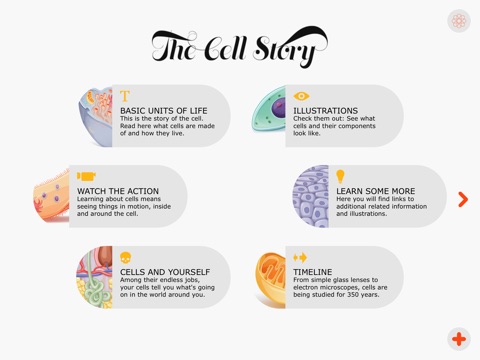
*** Free for the first week of launch! ***
This is the story of the exciting life of cells - the building blocks of all living things including us, humans.
The Cell Story is an interactive application that enables you to choose your own learning path through layers of text, video, audio, animations, illustrations, timeline, web-based knowledge, and more.
You are welcome not only to read through the material like any other e-book, but also to skip to other sections through the yellow icons which enable you to find added value content on whats interesting for you. Any way you choose to navigate through the different layers is the correct way. There is no one "right" way to learn.
"The Cell Story" application has 6 layers:
Layer 1 – Basic Units of Life (text based layer)
This text-based layer contains 14 sections. It explains in non-academic English what cells are made of, how they live, and includes a built-in glossary and quiz at the end.
Layer 2 – Illustrations (image-based layer)
Dozens of original illustrations and diagrams as well as related images demonstrate in high resolution and meticulous details animal cells, plant cell, cell divisions, DNA, and much more.
Layer 3 – Watch the Action (video- and animation-based layer)
The most important processes that happen inside the cell, explained through motion, text, music, and a human voiceover. These processes include action in the membrane, mitosis & meiosis (cell division), action of sunlight in the chloroplast, and more.
Layer 4 – Learn Some More
Links to additional related online knowledge specifically chosen to provide added value and to enhance learning.
Layer 5 – Cells and Yourself
Through our 5 senses, cells tell you what goes on in the world around you. Learn how cells connect you to the world.
Layer 6 – Timeline
The historical side of Cell Story uncovers the growth of knowledge about cells through stories of pioneering scientists and groundbreaking discoveries. From the humble beginning, using ridiculously primitive microscopes in the 17th century, to the scanning electron microscope in the 21th century.
The scientific contents of this application are in compliance with the disciplinary core idea included in the NRC document: Framework for K-12 Science Education, which serves as a basis for NGSS LS1.A: Structure and Function for middle school, as well as with the science standard curriculum for grades 7-8 of most state boards of education in the US, including New York, California, Massachusetts, Texas, New Jersey, and Connecticut.



